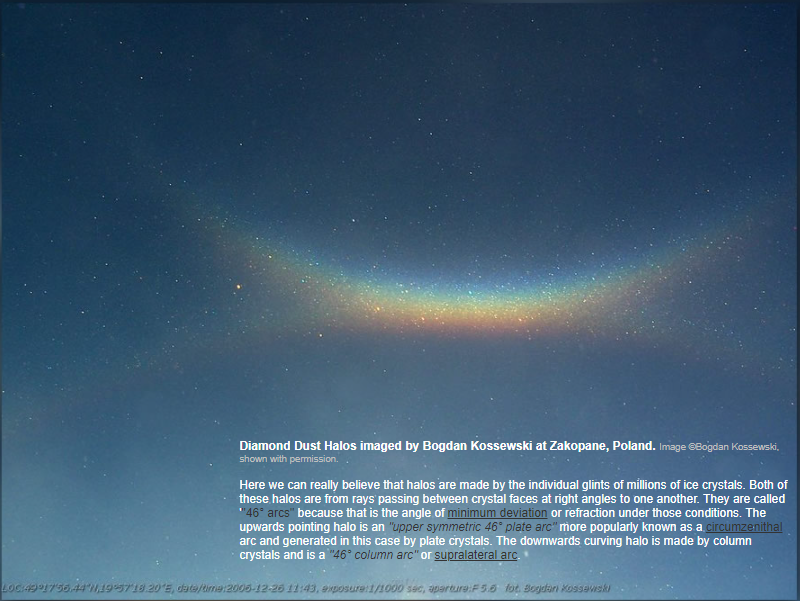46° arcs
Exploring the Fascinating Phenomenon of 46° Arcs in Atmospheric Optics
Atmospheric optics never ceases to amaze us with its breathtaking displays of natural beauty. One such mesmerizing phenomenon is the occurrence of "46° arcs." These arcs, also known as circumzenithal arcs and supralateral arcs, are formed by the interaction of sunlight with countless ice crystals suspended in the atmosphere. In this article, we will delve deeper into the captivating world of 46° arcs and uncover the secrets behind their formation.
To truly grasp the origin of 46° arcs, we must first understand the role of ice crystals in their creation. These crystals act as tiny prisms, bending and refracting sunlight as it passes through them. The unique geometry of these crystals gives rise to the remarkable 46° arcs, which occur when rays of sunlight pass between crystal faces at right angles to one another.
The term "46° arcs" stems from the angle of minimum deviation or refraction that occurs under these specific conditions. It is this angle that defines the distinct shape and curvature of these arcs. Let's explore the two main types of 46° arcs:
-
Circumzenithal Arcs: Also known as "upper symmetric 46° plate arcs," these arcs manifest as upward-pointing halos in the sky. They are primarily generated by plate-shaped ice crystals. The light rays passing through these crystals create a stunning display of colors, forming a halo resembling an upside-down rainbow. Circumzenithal arcs often appear as a vibrant band of colors positioned above the sun.
-
Supralateral Arcs: Formed by column-shaped ice crystals, supralateral arcs exhibit a distinctive downward curvature. These arcs, also referred to as "46° column arcs," grace the sky with their graceful presence. The interaction of sunlight with these crystals results in a beautiful arc that appears to bend downwards from the sun, mirroring the shape of a rainbow.
Now that we have familiarized ourselves with the basics of 46° arcs, let's explore some additional intriguing details:
-
Crystal Orientation: The orientation of the ice crystals plays a crucial role in determining the appearance of 46° arcs. The precise angles at which the crystal faces intersect influence the shape, size, and intensity of these arcs.
-
Weather Conditions: The presence of 46° arcs is often indicative of specific weather conditions. These arcs are commonly observed in cold regions where ice crystals can form in the atmosphere. Additionally, the presence of high-altitude cirrus clouds, which consist of ice crystals, enhances the likelihood of witnessing these captivating optical phenomena.
-
Optical Simplicity: Despite their mesmerizing appearance, 46° arcs are relatively simple in terms of optical processes involved. Unlike complex phenomena such as rainbows or halos, 46° arcs result from straightforward interactions between sunlight and ice crystals. This simplicity adds to their allure, making them a fascinating subject for atmospheric optics enthusiasts.
-
Rare Occurrence: While 46° arcs may not be as well-known as other atmospheric optics phenomena, they are no less captivating. These arcs tend to be rarer than rainbows or halos, making their sighting a special and awe-inspiring event for those fortunate enough to witness them.
-
Photographic Delights: Photographers have a field day capturing the ethereal beauty of 46° arcs. The vibrant colors and unique shapes of these arcs make them a favorite subject for photographers seeking to capture the magic of atmospheric optics. With the right equipment and timing, stunning images of 46° arcs can be immortalized.
In conclusion, the world of atmospheric optics never ceases to amaze us, and the occurrence of 46° arcs is a testament to the wonders of nature. These captivating optical phenomena, generated by the interaction of sunlight with ice crystals, offer a glimpse into the intricate beauty that surrounds us. Whether it's the mesmerizing circumzenithal arcs or the graceful supralateral arcs, the sight of these arcs in the sky leaves us in awe of the remarkable processes occurring above us. So, keep your eyes to the heavens and be ready to witness the magic of 46° arcs whenever nature decides to unveil its secrets.

Diamond Dust Halos imaged by Bogdan Kossewski at Zakopane, Poland. Image ©Bogdan Kossewski, shown with permission.
Here we can really believe that halos are made by the individual glints of millions of ice crystals. Both of these halos are from rays passing between crystal faces at right angles to one another. They are called '"46° arcs" because that is the angle of minimum deviation or refraction under those conditions. The upwards pointing halo is an "upper symmetric 46° plate arc" more popularly known as a circumzenithal arc and generated in this case by plate crystals. The downwards curving halo is made by column crystals and is a "46° column arc" or supralateral arc.
Note: this article has been automatically converted from the old site and may not appear as intended. You can find the original article here.
Reference Atmospheric Optics
If you use any of the definitions, information, or data presented on Atmospheric Optics, please copy the link or reference below to properly credit us as the reference source. Thank you!
-
<a href="https://atoptics.co.uk/blog/46-arcs/">46° arcs</a>
-
"46° arcs". Atmospheric Optics. Accessed on November 24, 2024. https://atoptics.co.uk/blog/46-arcs/.
-
"46° arcs". Atmospheric Optics, https://atoptics.co.uk/blog/46-arcs/. Accessed 24 November, 2024
-
46° arcs. Atmospheric Optics. Retrieved from https://atoptics.co.uk/blog/46-arcs/.